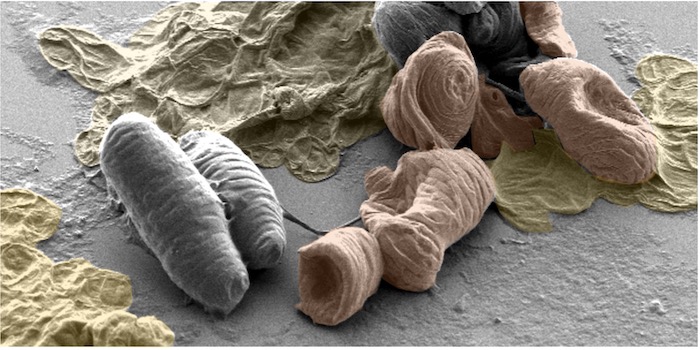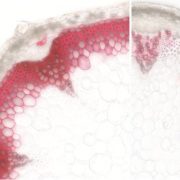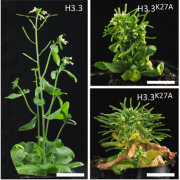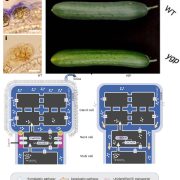Specific lignin chemistries tune the hydraulic and biomechanical properties of each plant sap conduction pipe to resist/recover from drought
Ménard et al. examine the properties of lignin in the plant vasculature.
Delphine Ménard1,2 and Edouard Pesquet1,2,3
1 Department of Ecology, Environment and Plant Sciences (DEEP), Stockholm University, 106 91 Stockholm, Sweden
2 Umeå Plant Science Centre (UPSC), Department of Plant Physiology, Umeå University, 901 87 Umeå, Sweden
3 Bolin Centre for Climate Research, Stockholm University, 106 91 Stockholm, Sweden
Background: Lignin comprises multiple cell wall–localized aromatic polymers that are essential for vascular plants to conduct water and strengthen their organs. It has long been thought that lignin was randomly and non-specifically assembled to provide mechanical strengthening and waterproofing to cells by filling-up the empty spaces in the cell walls. However, the different cell types and morphotypes forming the different sap-conducting pipes and their cell wall layers (inner vs outer layer) exhibit specific lignin chemistries that are conserved among plant species. We therefore investigated the function of these specific lignin chemistries at the cell and cell wall layer levels for the different sap-conducting pipes in plants.
Question: What is the function of a specific lignin chemistry for the different plant sap-conducting pipe cells? Can changes in the lignin chemistry of sap-conducting cells affect their hydraulic capacity when facing environmental conditions such as drought?
Findings: We answered these questions by changing lignin levels and composition, using drugs to block lignin formation and/or genetic engineering to switch off genes, in three complementary systems: (1) isolated cells grown in test tubes that we can trigger to become sap conduits, (2) annual plants, and (3) hardwood trees. We show that lignin chemistry is specific to each cell morphotype and changes during cell maturation, modifying the amount of lignin, the chemical composition of lignin units and the position of these units in the longer polymer. These specific lignin chemistries are required for the proper function of each cell morphotype to properly conduct the sap and strengthen plant organs. Modifying the amount, the composition, and the time when specific units with distinct chemistry are incorporated in lignin of each cell morphotype has dramatic effects, causing defects in sap conduit hydraulic and biomechanical properties. The ratio between the different chemical units of lignin needs to be fine-tuned to adjust plant sap conduction and mechanical strengthening. Thus, changes in the proportion of lignin units with distinct chemistries confer different hydraulic and mechanical properties enabling plants to better resist and/or recover from drought. We also revealed that increases in the proportion of lignin units with aldehyde modulate plant pipe hydraulic and mechanical properties.

Scanning Electron Microscopy (SEM) image of isolated tracheary elements produced using inducible pluripotent cell suspension cultures under air-drying to illustrate the strength of lignified cell wall to resist negative pressure. Fully lignified cells (in grey) resist collapse, cells with intermediate lignin levels (in red) partly collapse whereas cells without lignin (in yellow) are completely flatten and unable to sustain negative pressures. Image taken by Chen Choo Lee (Umeå University), sample prepared by Delphine Ménard and Edouard Pesquet (Stockholm University).
Next steps: We are now working to identify and understand the molecular mechanisms that control the formation of specific lignin chemistries in distinct sites and times during the development of the different cell wall layers in each cell type and morphotype.
Reference:
Delphine Ménard, Leonard Blaschek, Konstantin Kriechbaum, Cheng Choo Lee, Henrik Serk, Chuantao Zhu, Alexander Lyubartsev, Nuoendagula, Zoltán Bacsik, Lennart Bergström, Aji Mathew, Shinya Kajita, and Edouard Pesquet (2022). Plant biomechanics and resilience to environmental changes are controlled by specific lignin chemistries in each vascular cell type and morphotype. Plant Cell. https://doi.org/10.1093/plcell/koac284







